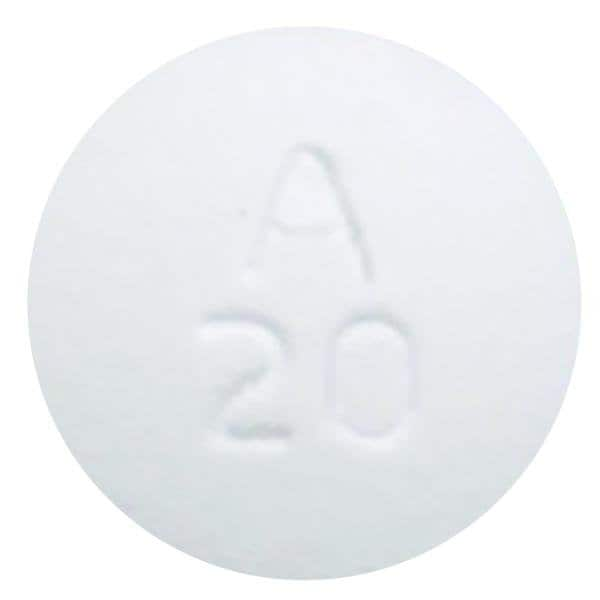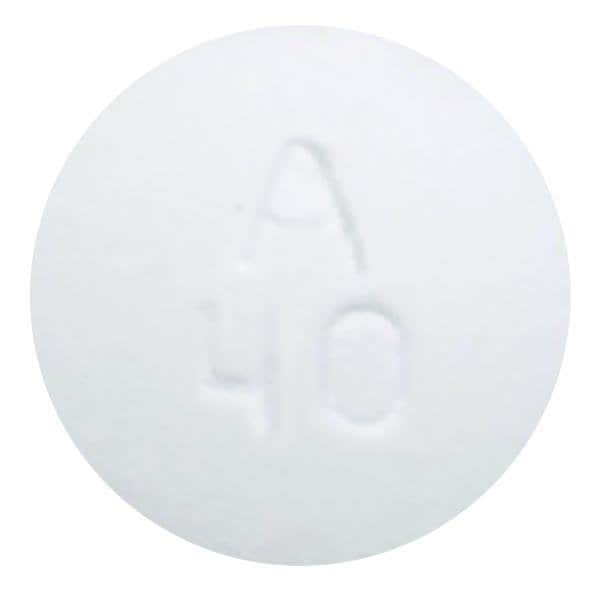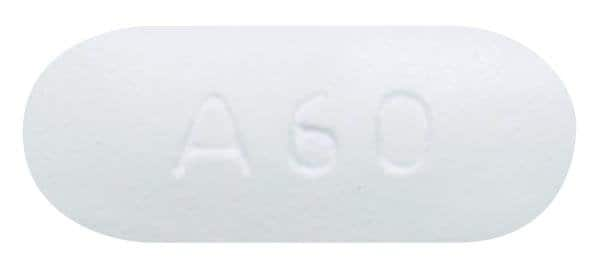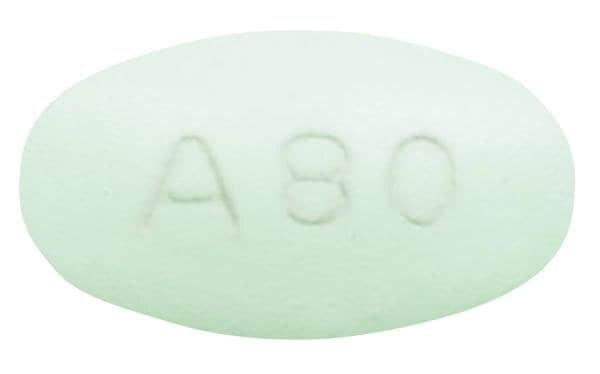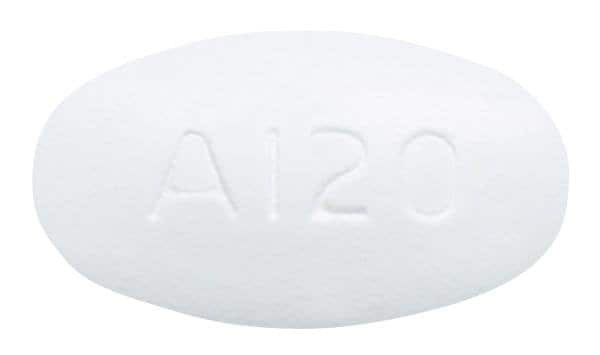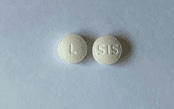Boxed Warning
Increased mortality in elderly patients with dementia-related psychosis:
Elderly patients with dementia-related psychosis treated with antipsychotic drugs are at an increased risk of death. Lurasidone is not approved for the treatment of patients with dementia-related psychosis.
Suicidal thoughts and behaviors:
Antidepressants increased the risk of suicidal thoughts and behavior in pediatric and young adult patients in short-term studies. Closely monitor all antidepressant-treated patients for clinical worsening, and for emergence of suicidal thoughts and behaviors.
Dosage Forms
Excipient information presented when available (limited, particularly for generics); consult specific product labeling.
Tablet, Oral, as hydrochloride:
Latuda: 20 mg, 40 mg, 60 mg
Latuda: 80 mg [contains fd&c blue #2 aluminum lake]
Latuda: 120 mg
Pharmacology
Mechanism of Action
Lurasidone is a benzoisothiazol-derivative atypical antipsychotic with mixed serotonin-dopamine antagonist activity. It exhibits high affinity for D2, 5-HT2A, and 5-HT7 receptors; moderate affinity for alpha2C-adrenergic receptors; and is a partial agonist for 5-HT1A receptors. Lurasidone has no significant affinity for muscarinic M1 and histamine H1 receptors. The addition of serotonin antagonism to dopamine antagonism (classic neuroleptic mechanism) is thought to improve negative symptoms of psychoses and reduce the incidence of extrapyramidal side effects as compared to typical antipsychotics (Huttunen 1995).
Pharmacokinetics/Pharmacodynamics
Absorption
Increased in fed state.
Distribution
Vd: 6,173 L
Metabolism
Primarily via CYP3A4; two active metabolites (ID-14283 and ID-14326) and two major nonactive metabolites (ID-20219 and ID-20220) produced
Excretion
Urine (~9%); feces (~80%)
Time to Peak
1 to 3 hours; steady state concentrations achieved within 7 days
Half-Life Elimination
18 to 40 hours; Main active metabolite, ID-14283 (exo-hydroxy metabolite), exhibits a half-life of 7.5 to 10 hours (Citrome 2011)
Protein Binding
~99%
Use in Specific Populations
Special Populations: Renal Function Impairment
In patients with mild, moderate, or severe renal impairment, mean Cmax increased by 40%, 92%, and 54%, respectively, and mean AUC0-∞ increased by 53%, 91%, and 2 times, respectively, compared with healthy matched subjects (Citrome 2011).
Special Populations: Hepatic Function Impairment
Mean AUC0-last was 1.5 times higher in subjects with mild hepatic impairment (Child-Pugh class A), 1.7 times higher in subjects with moderate hepatic impairment (Child-Pugh class B), and 3 times higher in subjects with severe hepatic impairment (Child-Pugh class C) compared with the values for healthy matched subjects. Mean Cmax was 1.3, 1.2, and 1.3 times higher for patients with mild, moderate, and severe hepatic impairment, respectively, compared with the values for healthy matched subjects (Citrome 2011).
Use: Labeled Indications
Bipolar depression: Treatment of depressive episodes associated with bipolar I disorder, both as monotherapy (children ≥10 years of age, adolescents, and adults) and as an adjunct to lithium or divalproex (adults)
Schizophrenia: Treatment of adults and adolescents with schizophrenia
Use: Off Label
Major depressive disorder with mixed featuresb
Data from a randomized, double-blind, placebo-controlled study supports the use of lurasidone in the treatment of major depressive disorder (MDD) with mixed features (hypomanic symptoms)
Psychosis/agitation associated with dementiayes
Based on the American Psychiatric Association practice guideline on the use of antipsychotics to treat agitation or psychosis in patients with dementia, antipsychotics, such as lurasidone, may be considered for the treatment of agitation and psychosis in certain patients with dementia; however, evidence for efficacy is modest and use should be limited to patients whose symptoms are dangerous, severe, or cause significant patient distress due to safety risks associated with antipsychotic use.
Contraindications
Hypersensitivity to lurasidone or any component of the formulation (including angioedema); concomitant use with strong CYP3A4 inhibitors (eg, ketoconazole, clarithromycin, ritonavir, voriconazole, mibefradil) and inducers (eg, rifampin, avasimibe, St. John's wort, phenytoin, carbamazepine).
Dosage and Administration
Dosing: Adult
Bipolar depression (monotherapy or as adjunct to lithium or divalproex): Oral: Initial: 20 mg once daily in the evening; may increase dose further based on response and tolerability in 20 mg increments every 2 to 7 days up to 120 mg/day (Chapel 2016; Loebel 2014a; Loebel 2014b); maximum recommended dose: 120 mg/day.
Major depressive disorder with mixed features (off-label use): Initial: 20 mg once daily; after 1 week, may increase based on response and tolerability up to 60 mg/day. The mean dose studied was 36.2 mg/day (Suppes 2016)
Schizophrenia: Oral: Initial: 40 mg once daily; may increase dose further based on response and tolerability; maximum recommended dose: 160 mg/day
Concomitant CYP3A4 inhibitors/inducers:
CYP3A4 inhibitors:
Concomitant administration with a strong CYP3A4 inhibitor (eg, ketoconazole, clarithromycin, ritonavir, voriconazole, mibefradil): Use is contraindicated.
Concomitant administration with a moderate CYP3A4 inhibitor (eg, diltiazem, atazanavir, erythromycin, fluconazole, verapamil): Initial dose: 20 mg once daily; do not exceed 80 mg/day of lurasidone. Note: If moderate CYP3A4 inhibitor is added to therapy, reduce lurasidone dose to 50% of original dose.
CYP3A4 inducers:
Concomitant administration with a strong CYP3A4 inducer (eg, rifampin, avasimibe, St John's wort, phenytoin, carbamazepine): Use is contraindicated.
Concomitant administration with a moderate CYP3A4 inducer: Lurasidone dose may need to be increased when combined with a moderate CYP3A4 inducer for ≥7 days.
Discontinuation of therapy: The American Psychiatric Association (APA), Canadian Psychiatric Association (CPA), and World Federation of Societies of Biological Psychiatry (WFSBP) guidelines recommend gradually tapering antipsychotics to avoid withdrawal symptoms and minimize the risk of relapse (APA [Lehman 2004]; Cerovecki 2013; CPA [Addington 2005]; WFSBP [Hasan 2012]); risk for withdrawal symptoms may be highest with highly anti-cholinergic or dopaminergic antipsychotics (Cerovecki 2013). When stopping antipsychotic therapy in patients with schizophrenia, the CPA guidelines recommend a gradual taper over 6 to 24 months, and the APA guidelines recommend reducing the dose by 10% each month (APA [Lehman 2004]; CPA [Addington 2005]). Continuing anti-parkinsonism agents for a brief period after discontinuation may prevent withdrawal symptoms (Cerovecki 2013). When switching antipsychotics, 3 strategies have been suggested: cross-titration (gradually discontinuing the first antipsychotic while gradually increasing the new antipsychotic), overlap and taper (maintaining the dose of the first antipsychotic while gradually increasing the new antipsychotic, then tapering the first antipsychotic), and abrupt change (abruptly discontinuing the first antipsychotic and either increasing the new antipsychotic gradually or starting it at a treatment dose). Evidence supporting ideal switch strategies and taper rates is limited, and results are conflicting (Cerovecki 2013; Remington 2005).
Dosing: Geriatric
Refer to adult dosing.
Psychosis/agitation associated with dementia (off-label use): Oral: Initial: One-third to one-half the usual dose to treat psychosis in younger adults or the smallest available dosage. In patients without a clinically significant response after 4 weeks, taper and withdraw therapy. In patients with an adequate response, attempt to taper and withdraw therapy within 4 months, unless symptoms recurred with a previous taper attempt. Assess symptoms at least monthly during taper and for at least 4 months after withdrawal of therapy (APA [Reus 2016]).
Dosing: Pediatric
Bipolar depression (monotherapy): Children ≥10 years of age and Adolescents: Oral: Initial: 20 mg once daily; may increase dose after 1 week based on response and tolerability; maximum recommended dose: 80 mg/day
Schizophrenia: Adolescents: Oral: Initial: 40 mg once daily; may increase dose further based on response and tolerability; maximum recommended dose: 80 mg/day
Concomitant CYP3A4 inhibitors/inducers: Refer to adult dosing.
Discontinuation of therapy: Refer to adult dosing.
Administration
Administer with food (≥350 calories).
Dietary Considerations
Should be taken with food (≥350 calories). Avoid grapefruit and grapefruit juice.
Storage
Store at 25°C (77°F); excursions permitted to 15°C to 30°C (59°F to 86°F).
Lurasidone Images
Drug Interactions
Acetylcholinesterase Inhibitors (Central): May enhance the neurotoxic (central) effect of Antipsychotic Agents. Severe extrapyramidal symptoms have occurred in some patients. Monitor therapy
Alcohol (Ethyl): CNS Depressants may enhance the CNS depressant effect of Alcohol (Ethyl). Monitor therapy
Alizapride: May enhance the CNS depressant effect of CNS Depressants. Monitor therapy
Amifampridine: Agents With Seizure Threshold Lowering Potential may enhance the neuroexcitatory and/or seizure-potentiating effect of Amifampridine. Monitor therapy
Amisulpride: Antipsychotic Agents may enhance the adverse/toxic effect of Amisulpride. Management: Drugs listed as exceptions to this monograph are discussed in further detail in separate drug interaction monographs. Avoid combination
Amphetamines: Antipsychotic Agents may diminish the stimulatory effect of Amphetamines. Monitor therapy
Antidiabetic Agents: Hyperglycemia-Associated Agents may diminish the therapeutic effect of Antidiabetic Agents. Monitor therapy
Anti-Parkinson Agents (Dopamine Agonist): Antipsychotic Agents (Second Generation [Atypical]) may diminish the therapeutic effect of Anti-Parkinson Agents (Dopamine Agonist). Management: Consider using an alternative antipsychotic agent when possible in patients with Parkinson disease. If an atypical antipsychotic is necessary, consider using clozapine or quetiapine, which may convey the lowest interaction risk. Consider therapy modification
ARIPiprazole: CYP3A4 Inhibitors (Weak) may increase the serum concentration of ARIPiprazole. Management: Monitor for increased aripiprazole pharmacologic effects. Aripiprazole dose adjustments may or may not be required based on concomitant therapy and/or indication. Consult full interaction monograph for specific recommendations. Monitor therapy
Atazanavir: May increase the serum concentration of Lurasidone. Management: Atazanavir labeling recommends reducing the lurasidone dose as directed by the lurasidone labeling for moderate CYP3A4 inhibitors when used together with lurasidone. Consider therapy modification
Azelastine (Nasal): CNS Depressants may enhance the CNS depressant effect of Azelastine (Nasal). Avoid combination
Blonanserin: CNS Depressants may enhance the CNS depressant effect of Blonanserin. Consider therapy modification
Blood Pressure Lowering Agents: May enhance the hypotensive effect of Antipsychotic Agents (Second Generation [Atypical]). Monitor therapy
Brexanolone: CNS Depressants may enhance the CNS depressant effect of Brexanolone. Monitor therapy
Brimonidine (Topical): May enhance the CNS depressant effect of CNS Depressants. Monitor therapy
Bromopride: May enhance the adverse/toxic effect of Antipsychotic Agents. Avoid combination
Bromperidol: May enhance the CNS depressant effect of CNS Depressants. Avoid combination
Buprenorphine: CNS Depressants may enhance the CNS depressant effect of Buprenorphine. Management: Consider reduced doses of other CNS depressants, and avoiding such drugs in patients at high risk of buprenorphine overuse/self-injection. Initiate buprenorphine at lower doses in patients already receiving CNS depressants. Consider therapy modification
BuPROPion: May enhance the neuroexcitatory and/or seizure-potentiating effect of Agents With Seizure Threshold Lowering Potential. Monitor therapy
Cannabidiol: May enhance the CNS depressant effect of CNS Depressants. Monitor therapy
Cannabis: May enhance the CNS depressant effect of CNS Depressants. Monitor therapy
Chlormethiazole: May enhance the CNS depressant effect of CNS Depressants. Management: Monitor closely for evidence of excessive CNS depression. The chlormethiazole labeling states that an appropriately reduced dose should be used if such a combination must be used. Consider therapy modification
Chlorphenesin Carbamate: May enhance the adverse/toxic effect of CNS Depressants. Monitor therapy
Clofazimine: May increase the serum concentration of CYP3A4 Substrates (High risk with Inhibitors). Monitor therapy
CNS Depressants: May enhance the adverse/toxic effect of other CNS Depressants. Monitor therapy
Conivaptan: May increase the serum concentration of CYP3A4 Substrates (High risk with Inhibitors). Avoid combination
CYP3A4 Inducers (Moderate): May decrease the serum concentration of Lurasidone. Management: Monitor for decreased lurasidone effects if combined with moderate CYP3A4 inducers and consider increasing the lurasidone dose if coadministered with a moderate CYP3A4 inducer for 7 or more days. Consider therapy modification
CYP3A4 Inducers (Strong): May decrease the serum concentration of Lurasidone. Avoid combination
CYP3A4 Inhibitors (Moderate): May increase the serum concentration of Lurasidone. Management: Lurasidone US labeling recommends reducing lurasidone dose by half with a moderate CYP3A4 inhibitor. Some non-US labeling recommends initiating lurasidone at 20 mg/day and limiting dose to 40 mg/day; avoid concurrent use of grapefruit products. Consider therapy modification
CYP3A4 Inhibitors (Strong): May increase the serum concentration of Lurasidone. Avoid combination
Dabrafenib: May decrease the serum concentration of CYP3A4 Substrates (High risk with Inducers). Management: Seek alternatives to the CYP3A4 substrate when possible. If concomitant therapy cannot be avoided, monitor clinical effects of the substrate closely (particularly therapeutic effects). Consider therapy modification
Deferasirox: May decrease the serum concentration of CYP3A4 Substrates (High risk with Inducers). Monitor therapy
Deutetrabenazine: May enhance the adverse/toxic effect of Antipsychotic Agents. Specifically, the risk for akathisia, parkinsonism, or neuroleptic malignant syndrome may be increased. Monitor therapy
Dimethindene (Topical): May enhance the CNS depressant effect of CNS Depressants. Monitor therapy
Disopyramide: Lurasidone may enhance the QTc-prolonging effect of Disopyramide. Management: Consider alternatives to disopyramide in patients with acute lurasidone overdose. If disopyramide treatment cannot be avoided, monitor for excessive QTc interval prolongation. Consider therapy modification
Dofetilide: CYP3A4 Inhibitors (Weak) may increase the serum concentration of Dofetilide. Monitor therapy
DOPamine: May enhance the hypotensive effect of Lurasidone. Avoid combination
Doxylamine: May enhance the CNS depressant effect of CNS Depressants. Management: The manufacturer of Diclegis (doxylamine/pyridoxine), intended for use in pregnancy, specifically states that use with other CNS depressants is not recommended. Monitor therapy
Dronabinol: May enhance the CNS depressant effect of CNS Depressants. Monitor therapy
Droperidol: May enhance the CNS depressant effect of CNS Depressants. Management: Consider dose reductions of droperidol or of other CNS agents (eg, opioids, barbiturates) with concomitant use. Exceptions to this monograph are discussed in further detail in separate drug interaction monographs. Consider therapy modification
EPINEPHrine (Systemic): May enhance the hypotensive effect of Lurasidone. Avoid combination
Erdafitinib: May decrease the serum concentration of CYP3A4 Substrates (High risk with Inducers). Monitor therapy
Erdafitinib: May increase the serum concentration of CYP3A4 Substrates (High risk with Inhibitors). Monitor therapy
Esketamine: May enhance the CNS depressant effect of CNS Depressants. Monitor therapy
Flibanserin: CYP3A4 Inhibitors (Weak) may increase the serum concentration of Flibanserin. Monitor therapy
Flunitrazepam: CNS Depressants may enhance the CNS depressant effect of Flunitrazepam. Consider therapy modification
Fosaprepitant: May increase the serum concentration of CYP3A4 Substrates (High risk with Inhibitors). Monitor therapy
Fusidic Acid (Systemic): May increase the serum concentration of CYP3A4 Substrates (High risk with Inhibitors). Avoid combination
Grapefruit Juice: May increase the serum concentration of Lurasidone. Avoid combination
Guanethidine: Antipsychotic Agents may diminish the therapeutic effect of Guanethidine. Monitor therapy
HYDROcodone: CNS Depressants may enhance the CNS depressant effect of HYDROcodone. Management: Avoid concomitant use of hydrocodone and benzodiazepines or other CNS depressants when possible. These agents should only be combined if alternative treatment options are inadequate. If combined, limit the dosages and duration of each drug. Consider therapy modification
HydrOXYzine: May enhance the CNS depressant effect of CNS Depressants. Monitor therapy
Idelalisib: May increase the serum concentration of CYP3A4 Substrates (High risk with Inhibitors). Avoid combination
Iohexol: Agents With Seizure Threshold Lowering Potential may enhance the adverse/toxic effect of Iohexol. Specifically, the risk for seizures may be increased. Management: Discontinue agents that may lower the seizure threshold 48 hours prior to intrathecal use of iohexol. Wait at least 24 hours after the procedure to resume such agents. In nonelective procedures, consider use of prophylactic anticonvulsants. Consider therapy modification
Iomeprol: Agents With Seizure Threshold Lowering Potential may enhance the adverse/toxic effect of Iomeprol. Specifically, the risk for seizures may be increased. Management: Discontinue agents that may lower the seizure threshold 48 hours prior to intrathecal use of iomeprol. Wait at least 24 hours after the procedure to resume such agents. In nonelective procedures, consider use of prophylactic anticonvulsants. Consider therapy modification
Iopamidol: Agents With Seizure Threshold Lowering Potential may enhance the adverse/toxic effect of Iopamidol. Specifically, the risk for seizures may be increased. Management: Discontinue agents that may lower the seizure threshold 48 hours prior to intrathecal use of iopamidol. Wait at least 24 hours after the procedure to resume such agents. In nonelective procedures, consider use of prophylactic anticonvulsants. Consider therapy modification
Ivosidenib: May decrease the serum concentration of CYP3A4 Substrates (High risk with Inducers). Monitor therapy
Kava Kava: May enhance the adverse/toxic effect of CNS Depressants. Monitor therapy
Larotrectinib: May increase the serum concentration of CYP3A4 Substrates (High risk with Inhibitors). Monitor therapy
Lemborexant: CYP3A4 Inhibitors (Weak) may increase the serum concentration of Lemborexant. Management: The maximum recommended dosage of lemborexant is 5 mg, no more than once per night, when coadministered with weak CYP3A4 inhibitors. Consider therapy modification
Lemborexant: May enhance the CNS depressant effect of CNS Depressants. Management: Dosage adjustments of lemborexant and of concomitant CNS depressants may be necessary when administered together because of potentially additive CNS depressant effects. Close monitoring for CNS depressant effects is necessary. Consider therapy modification
Lithium: May enhance the neurotoxic effect of Antipsychotic Agents. Lithium may decrease the serum concentration of Antipsychotic Agents. Specifically noted with chlorpromazine. Monitor therapy
Lofexidine: May enhance the CNS depressant effect of CNS Depressants. Management: Drugs listed as exceptions to this monograph are discussed in further detail in separate drug interaction monographs. Monitor therapy
Lomitapide: CYP3A4 Inhibitors (Weak) may increase the serum concentration of Lomitapide. Management: Patients on lomitapide 5 mg/day may continue that dose. Patients taking lomitapide 10 mg/day or more should decrease the lomitapide dose by half. The lomitapide dose may then be titrated up to a max adult dose of 30 mg/day. Consider therapy modification
Lorlatinib: May decrease the serum concentration of CYP3A4 Substrates (High risk with Inducers). Management: Avoid concurrent use of lorlatinib with any CYP3A4 substrates for which a minimal decrease in serum concentrations of the CYP3A4 substrate could lead to therapeutic failure and serious clinical consequences. Consider therapy modification
Magnesium Sulfate: May enhance the CNS depressant effect of CNS Depressants. Monitor therapy
Mequitazine: Antipsychotic Agents may enhance the arrhythmogenic effect of Mequitazine. Management: Consider alternatives to one of these agents when possible. While this combination is not specifically contraindicated, mequitazine labeling describes this combination as discouraged. Consider therapy modification
Methotrimeprazine: CNS Depressants may enhance the CNS depressant effect of Methotrimeprazine. Methotrimeprazine may enhance the CNS depressant effect of CNS Depressants. Management: Reduce adult dose of CNS depressant agents by 50% with initiation of concomitant methotrimeprazine therapy. Further CNS depressant dosage adjustments should be initiated only after clinically effective methotrimeprazine dose is established. Consider therapy modification
Methylphenidate: Antipsychotic Agents may enhance the adverse/toxic effect of Methylphenidate. Methylphenidate may enhance the adverse/toxic effect of Antipsychotic Agents. Monitor therapy
Metoclopramide: May enhance the adverse/toxic effect of Antipsychotic Agents. Avoid combination
MetyroSINE: CNS Depressants may enhance the sedative effect of MetyroSINE. Monitor therapy
MetyroSINE: May enhance the adverse/toxic effect of Antipsychotic Agents. Monitor therapy
Minocycline (Systemic): May enhance the CNS depressant effect of CNS Depressants. Monitor therapy
Nabilone: May enhance the CNS depressant effect of CNS Depressants. Monitor therapy
NiMODipine: CYP3A4 Inhibitors (Weak) may increase the serum concentration of NiMODipine. Monitor therapy
Opioid Agonists: CNS Depressants may enhance the CNS depressant effect of Opioid Agonists. Management: Avoid concomitant use of opioid agonists and benzodiazepines or other CNS depressants when possible. These agents should only be combined if alternative treatment options are inadequate. If combined, limit the dosages and duration of each drug. Consider therapy modification
Orphenadrine: CNS Depressants may enhance the CNS depressant effect of Orphenadrine. Avoid combination
Oxomemazine: May enhance the CNS depressant effect of CNS Depressants. Avoid combination
OxyCODONE: CNS Depressants may enhance the CNS depressant effect of OxyCODONE. Management: Avoid concomitant use of oxycodone and benzodiazepines or other CNS depressants when possible. These agents should only be combined if alternative treatment options are inadequate. If combined, limit the dosages and duration of each drug. Consider therapy modification
Palbociclib: May increase the serum concentration of CYP3A4 Substrates (High risk with Inhibitors). Monitor therapy
Paraldehyde: CNS Depressants may enhance the CNS depressant effect of Paraldehyde. Avoid combination
Perampanel: May enhance the CNS depressant effect of CNS Depressants. Management: Patients taking perampanel with any other drug that has CNS depressant activities should avoid complex and high-risk activities, particularly those such as driving that require alertness and coordination, until they have experience using the combination. Consider therapy modification
Pimozide: CYP3A4 Inhibitors (Weak) may increase the serum concentration of Pimozide. Avoid combination
Piribedil: Antipsychotic Agents may diminish the therapeutic effect of Piribedil. Piribedil may diminish the therapeutic effect of Antipsychotic Agents. Management: Use of piribedil with antiemetic neuroleptics is contraindicated, and use with antipsychotic neuroleptics, except for clozapine, is not recommended. Avoid combination
Procainamide: Lurasidone may enhance the QTc-prolonging effect of Procainamide. Management: Consider alternatives to procainamide in patients with acute lurasidone overdose. If procainamide treatment cannot be avoided, monitor for excessive QTc interval prolongation. Consider therapy modification
Quinagolide: Antipsychotic Agents may diminish the therapeutic effect of Quinagolide. Monitor therapy
QuiNIDine: Lurasidone may enhance the QTc-prolonging effect of QuiNIDine. Management: Consider alternatives to quinidine in patients with acute lurasidone overdose. If quinidine treatment cannot be avoided, monitor for excessive QTc interval prolongation. Consider therapy modification
Rufinamide: May enhance the adverse/toxic effect of CNS Depressants. Specifically, sleepiness and dizziness may be enhanced. Monitor therapy
Sarilumab: May decrease the serum concentration of CYP3A4 Substrates (High risk with Inducers). Monitor therapy
Selective Serotonin Reuptake Inhibitors: CNS Depressants may enhance the adverse/toxic effect of Selective Serotonin Reuptake Inhibitors. Specifically, the risk of psychomotor impairment may be enhanced. Monitor therapy
Serotonergic Agents (High Risk): May enhance the adverse/toxic effect of Antipsychotic Agents. Specifically, serotonergic agents may enhance dopamine blockade, possibly increasing the risk for neuroleptic malignant syndrome. Antipsychotic Agents may enhance the serotonergic effect of Serotonergic Agents (High Risk). This could result in serotonin syndrome. Monitor therapy
Siltuximab: May decrease the serum concentration of CYP3A4 Substrates (High risk with Inducers). Monitor therapy
Simeprevir: May increase the serum concentration of CYP3A4 Substrates (High risk with Inhibitors). Monitor therapy
Sodium Oxybate: May enhance the CNS depressant effect of CNS Depressants. Management: Consider alternatives to combined use. When combined use is needed, consider minimizing doses of one or more drugs. Use of sodium oxybate with alcohol or sedative hypnotics is contraindicated. Consider therapy modification
St John's Wort: May decrease the serum concentration of Lurasidone. Avoid combination
Stiripentol: May increase the serum concentration of CYP3A4 Substrates (High risk with Inhibitors). Management: Use of stiripentol with CYP3A4 substrates that are considered to have a narrow therapeutic index should be avoided due to the increased risk for adverse effects and toxicity. Any CYP3A4 substrate used with stiripentol requires closer monitoring. Consider therapy modification
Sulpiride: Antipsychotic Agents may enhance the adverse/toxic effect of Sulpiride. Avoid combination
Suvorexant: CNS Depressants may enhance the CNS depressant effect of Suvorexant. Management: Dose reduction of suvorexant and/or any other CNS depressant may be necessary. Use of suvorexant with alcohol is not recommended, and the use of suvorexant with any other drug to treat insomnia is not recommended. Consider therapy modification
Tapentadol: May enhance the CNS depressant effect of CNS Depressants. Management: Avoid concomitant use of tapentadol and benzodiazepines or other CNS depressants when possible. These agents should only be combined if alternative treatment options are inadequate. If combined, limit the dosages and duration of each drug. Consider therapy modification
Tetrabenazine: May enhance the adverse/toxic effect of Antipsychotic Agents. Monitor therapy
Tetrahydrocannabinol: May enhance the CNS depressant effect of CNS Depressants. Monitor therapy
Tetrahydrocannabinol and Cannabidiol: May enhance the CNS depressant effect of CNS Depressants. Monitor therapy
Thalidomide: CNS Depressants may enhance the CNS depressant effect of Thalidomide. Avoid combination
Tocilizumab: May decrease the serum concentration of CYP3A4 Substrates (High risk with Inducers). Monitor therapy
Triazolam: CYP3A4 Inhibitors (Weak) may increase the serum concentration of Triazolam. Management: Consider triazolam dose reduction in patients receiving concomitant weak CYP3A4 inhibitors. Consider therapy modification
Trimeprazine: May enhance the CNS depressant effect of CNS Depressants. Monitor therapy
Ubrogepant: CYP3A4 Inhibitors (Weak) may increase the serum concentration of Ubrogepant. Management: In patients taking weak CYP3A4 inhibitors, the initial and second dose (if needed) of ubrogepant should be limited to 50 mg. Consider therapy modification
Zolpidem: CNS Depressants may enhance the CNS depressant effect of Zolpidem. Management: Reduce the Intermezzo brand sublingual zolpidem adult dose to 1.75 mg for men who are also receiving other CNS depressants. No such dose change is recommended for women. Avoid use with other CNS depressants at bedtime; avoid use with alcohol. Consider therapy modification
Adverse Reactions
>10%:
Endocrine & metabolic: Increased serum triglycerides (10% to 14%), increased serum cholesterol (6% to 14%), increased serum glucose (6% to 13%; fasting)
Gastrointestinal: Nausea (7% to 17%)
Infection: Viral infection (adolescents: 10% to 11%)
Nervous system: Extrapyramidal reaction (adults: 5% to 39%; children and adolescents: 6% to 14%), drowsiness (adults: 8% to 26%; children and adolescents: 11% to 15%), akathisia (adults: 6% to 22%; adolescents: 9%), parkinsonian-like syndrome (adults: 5% to 17%; adolescents: 4%), insomnia (5% to 11%)
1% to 10%:
Cardiovascular: Tachycardia (3%), orthostatic hypotension (≤3%), hypertension (adults: ≥1%)
Dermatologic: Pruritus (adults: ≥1%), skin rash (≥1%)
Endocrine & metabolic: Weight gain (2% to 7%), increased serum prolactin (≥5 x ULN: females: ≤6%; males: ≤2%)
Gastrointestinal: Dyspepsia (adults: 6% to 11%), vomiting (6% to 9%), xerostomia (adolescents and adults: 2% to 6%), diarrhea (3% to 5%), decreased appetite (children and adolescents: 4%; adults: ≥1%), sialorrhea (adults: 1% to 4%), abdominal pain (children and adolescents: 3%; adults: ≥1%), upper abdominal pain (children and adolescents: 3%)
Genitourinary: Urinary tract infection (adults: 1% to 2%)
Infection: Influenza (adults: 2%)
Nervous system: Agitation (adults: 5% to 10%), anxiety (adults: 4% to 7%), dystonia (adults: 2% to 7%; adolescents: ≤1%), dizziness (4% to 6%), fatigue (children and adolescents: 3%), restlessness (adults: 2% to 3%)
Neuromuscular & skeletal: Back pain (adults: 3% to 4%), increased creatine phosphokinase in blood specimen (adults: ≥1%), dyskinesia (adolescents: 1%)
Ophthalmic: Blurred vision (adults: ≥1%)
Renal: Increased serum creatinine (2% to 7%)
Respiratory: Rhinitis (adolescents: 8%), nasopharyngitis (adults: 4%), oropharyngeal pain (adolescents: ≤3%)
Frequency not defined: Nervous system: Suicidal ideation, suicidal tendencies, tardive dyskinesia
<1%, postmarketing, and/or case reports: Abnormal dreams, amenorrhea, anemia, angina pectoris, angioedema, bradycardia, breast hypertrophy, cerebrovascular accident, dysarthria, dysmenorrhea, dyspnea, dysuria, erectile dysfunction, first-degree atrioventricular block, galactorrhea, gastritis, hyponatremia, mastalgia, neuroleptic malignant syndrome, panic attack, pharyngeal edema, priapism, psychomotor agitation, renal failure syndrome, rhabdomyolysis, sleep disorder, syncope, tongue edema, urticaria, vertigo
Warnings/Precautions
Major psychiatric warnings:
- Suicidal thinking/behavior: [US Boxed Warning]: Antidepressants increased the risk of suicidal thoughts and behavior in pediatric and young adult patients in short-term studies; consider risk prior to prescribing. Closely monitor all antidepressant-treated patients for clinical worsening and for emergence of suicidal thoughts and behaviors, particularly during the initial 1 to 2 months of therapy or during periods of dosage adjustments (increases or decreases); the patient's family or caregiver should be instructed to closely observe the patient and communicate condition with healthcare provider. A medication guide concerning the use of antidepressants should be dispensed with each prescription.
- The possibility of a suicide attempt is inherent in major depression and may persist until remission occurs. Worsening depression and severe abrupt suicidality that are not part of the presenting symptoms may require discontinuation or modification of drug therapy. Use caution in high-risk patients during initiation of therapy.
- Prescriptions should be written for the smallest quantity consistent with good patient care. The patient's family or caregiver should be alerted to monitor patients for the emergence of suicidality and associated behaviors such as anxiety, agitation, panic attacks, insomnia, irritability, hostility, impulsivity, akathisia, hypomania, and mania; patients should be instructed to notify their healthcare provider if any of these symptoms or worsening depression or psychosis occur.
Concerns related to adverse effects:
- Altered cardiac conduction: Antipsychotics may alter cardiac conduction; life-threatening arrhythmias have occurred with therapeutic doses of antipsychotics (Haddad 2002). Relative to other antipsychotics, lurasidone has minimal effects on the QTc interval and therefore, risk for arrhythmias is low.
- Blood dyscrasias: Leukopenia, neutropenia, and agranulocytosis (sometimes fatal) have been reported in clinical trials and postmarketing reports with antipsychotic use; presence of risk factors (eg, preexisting low WBC or history of drug-induced leuko-/neutropenia) should prompt periodic blood count assessment. Discontinue therapy at first signs of blood dyscrasias or if absolute neutrophil count <1,000/mm3.
- CNS depression: May cause CNS depression, which may impair physical or mental abilities; patients must be cautioned about performing tasks that require mental alertness (eg, operating machinery, driving).
- Dyslipidemia: Increases in total cholesterol and triglyceride concentrations have been observed with atypical antipsychotic use; incidence varies with product. During clinical trials of lurasidone, there were no significant changes in total cholesterol or triglycerides observed. Compared to other antipsychotics, the risk of metabolic side effects like dyslipidemia with lurasidone is minimal to low (Solmi 2017).
- Esophageal dysmotility/aspiration: Antipsychotic use has been associated with esophageal dysmotility and aspiration; risk increases with age. Use with caution in patients at risk for aspiration pneumonia (eg, Alzheimer disease), particularly in patients >75 years (Herzig 2017; Maddalena 2004).
- Extrapyramidal symptoms: May cause extrapyramidal symptoms (EPS), including pseudoparkinsonism, acute dystonic reactions, akathisia, and tardive dyskinesia (risk of these reactions is generally much lower relative to typical/conventional antipsychotics; frequencies reported are similar to placebo). Risk of dystonia (and probably other EPS) may be greater with increased doses, use of conventional antipsychotics, males, and younger patients. Factors associated with greater vulnerability to tardive dyskinesia include older in age, female gender combined with postmenopausal status, Parkinson disease, pseudoparkinsonism symptoms, affective disorders (particularly major depressive disorder), concurrent medical diseases such as diabetes, previous brain damage, alcoholism, poor treatment response, and use of high doses of antipsychotics (APA [Lehman 2004]; Soares-Weiser 2007). Consider therapy discontinuation with signs/symptoms of tardive dyskinesia.
- Falls: May increase the risk for falls due to somnolence, orthostatic hypotension, and motor or sensory instability. Complete fall risk assessments at baseline and periodically during treatment in patients with diseases or on medications that may also increase fall risk.
- Hyperglycemia: Atypical antipsychotics have been associated with development of hyperglycemia; in some cases, may be extreme and associated with ketoacidosis, hyperosmolar coma, or death. Incidence varies with product; compared to other antipsychotics, the risk of metabolic side effects like hyperglycemia with lurasidone is minimal to low (Solmi 2017). Use with caution in patients with diabetes or other disorders of glucose regulation; monitor for worsening of glucose control.
- Hyperprolactinemia: Use is associated with increased prolactin levels; clinical significance of hyperprolactinemia in patients with breast cancer or other prolactin-dependent tumors is unknown.
- Neuroleptic malignant syndrome: Use may be associated with neuroleptic malignant syndrome (NMS); monitor for mental status changes, fever, muscle rigidity, and/or autonomic instability (risk may be increased in patients with Parkinson disease or Lewy body dementia) (McKeith 2002). If NMS is suspected, discontinue lurasidone and initiate symptomatic treatment and monitoring.
- Orthostatic hypotension: May cause orthostatic hypotension and syncope; use with caution in patients at risk of this effect (eg, concurrent medication use which may predispose to hypotension/bradycardia or presence of dehydration or hypovolemia) or in those who would not tolerate transient hypotensive episodes. Use caution with history of cerebrovascular or cardiovascular disease (myocardial infarction, heart failure, or ischemic disease).
- Temperature regulation: Impaired core body temperature regulation may occur; caution with strenuous exercise, heat exposure, dehydration, and concomitant medication possessing anticholinergic effects.
- Weight gain: Significant weight gain has been observed with antipsychotic therapy; incidence varies with product. Monitor waist circumference and BMI (ADA 2004; Lehman 2004; Marder 2004). Compared to other antipsychotics, the risk of weight gain with lurasidone is minimal to low (Solmi 2017).
Disease-related concerns:
- Cardiovascular disease: Use with caution in patients with severe cardiac disease, hemodynamic instability, prior myocardial infarction or ischemic heart disease.
- Dementia: [US Boxed Warning]: Elderly patients with dementia-related psychosis treated with antipsychotics are at an increased risk of death. Most deaths appeared to be either cardiovascular (eg, heart failure, sudden death) or infectious (eg, pneumonia) in nature. Use with caution in patients with Lewy body dementia or Parkinson disease dementia due to greater risk of adverse effects, increased sensitivity to extrapyramidal effects, and association with irreversible cognitive decompensation or death. (APA [Reus 2016]). Lurasidone is not approved for the treatment of dementia-related psychosis.
- Hepatic impairment: Use with caution in patients with hepatic disease or impairment; dosage reduction is recommended in moderate-to-severe impairment.
- Renal impairment: Use with caution in patients with renal disease; dosage reduction is recommended in moderate-to-severe impairment.
- Seizures: Use with caution in patients at risk of seizures, including those with a history of seizures or conditions that lower the seizure threshold such as Alzheimer disease. Elderly patients may be at increased risk of seizures due to an increased prevalence of predisposing factors.
Concurrent drug therapy issues:
- Drug-drug interactions: Potentially significant interactions may exist, requiring dose or frequency adjustment, additional monitoring, and/or selection of alternative therapy. Consult drug interactions database for more detailed information.
Other warnings/precautions:
- Discontinuation of therapy: When discontinuing antipsychotic therapy, the American Psychiatric Association (APA), Canadian Psychiatric Association (CPA), and World Federation of Societies of Biological Psychiatry (WFSBP) guidelines recommend gradually tapering antipsychotics to avoid physical withdrawal symptoms, including anorexia, anxiety, diaphoresis, diarrhea, dizziness, dyskinesia, headache, myalgia, nausea, paresthesia, restlessness, tremulousness, and vomiting (APA [Lehman 2004]; CPA [Addington 2005]; Lambert 2007; WFSBP [Hasan 2012]). The risk of withdrawal symptoms is highest following abrupt discontinuation of highly anti-cholinergic or dopaminergic antipsychotics (Cerovecki 2013). Additional factors such as duration of antipsychotic exposure, the indication for use, medication half-life and risk for relapse should be considered. In schizophrenia, there is no reliable indicator to differentiate the minority who will not from the majority who will relapse with drug discontinuation. However, studies in which the medication of well-stabilized patients were discontinued indicate that 75% of patients relapse within 6 to 24 months. Indefinite maintenance antipsychotic medication is generally recommended, and especially for patients who have had multiple prior episodes or 2 episodes within 5 years (APA [Lehman 2004]).
Monitoring Parameters
Mental status; vital signs (as clinically indicated); blood pressure (baseline; repeat 3 months after antipsychotic initiation, then yearly); weight, height, BMI, waist circumference (baseline; repeat at 4, 8, and 12 weeks after initiating or changing therapy, then quarterly; consider switching to a different antipsychotic for a weight gain ≥5% of initial weight); CBC (as clinically indicated; monitor frequently during the first few months of therapy in patients with preexisting low WBC or history of drug-induced leukopenia/neutropenia); electrolytes, renal and liver function (annually and as clinically indicated); personal and family history of obesity, diabetes, dyslipidemia, hypertension, or cardiovascular disease (baseline; repeat annually); fasting plasma glucose level/HbA1c (baseline; repeat 3 months after starting antipsychotic, then yearly); fasting lipid panel (baseline; repeat 3 months after initiation of antipsychotic; if LDL level is normal repeat at 2- to 5-year intervals or more frequently if clinically indicated); changes in menstruation, libido, development of galactorrhea, erectile and ejaculatory function (at each visit for the first 12 weeks after the antipsychotic is initiated or until the dose is stable, then yearly); abnormal involuntary movements or parkinsonian signs (baseline; repeat weekly until dose stabilized for at least 2 weeks after introduction and for 2 weeks after any significant dose increase); tardive dyskinesia (every 12 months; high-risk patients every 6 months); ocular examination (yearly in patients >40 years; every 2 years in younger patients) (ADA, 2004; Lehman, 2004; Marder, 2004).
Pregnancy
Pregnancy Considerations
Antipsychotic use during the third trimester of pregnancy has a risk for abnormal muscle movements (extrapyramidal symptoms [EPS]) and/or withdrawal symptoms in newborns following delivery. Symptoms in the newborn may include agitation, feeding disorder, hypertonia, hypotonia, respiratory distress, somnolence, and tremor; these effects may be self-limiting or require hospitalization. Lurasidone may cause hyperprolactinemia, which may decrease reproductive function in both males and females.
The ACOG recommends that therapy during pregnancy be individualized; treatment with psychiatric medications during pregnancy should incorporate the clinical expertise of the mental health clinician, obstetrician, primary healthcare provider, and pediatrician. Safety data related to atypical antipsychotics during pregnancy is limited and routine use is not recommended. However, if a woman is inadvertently exposed to an atypical antipsychotic while pregnant, continuing therapy may be preferable to switching to a typical antipsychotic that the fetus has not yet been exposed to; consider risk:benefit (ACOG 2008).
Health care providers are encouraged to enroll women 18 to 45 years of age exposed to lurasidone during pregnancy in the Atypical Antipsychotics Pregnancy Registry (866-961-2388 or http://www.womensmentalhealth.org/clinical-and-research-programs/pregnancyregistry).
Patient Education
What is this drug used for?
- It is used to treat schizophrenia.
- It is used to treat low mood (depression) in people with bipolar disorder.
- It may be given to you for other reasons. Talk with the doctor.
Frequently reported side effects of this drug
- Fatigue
- Runny nose
- Nausea
- Vomiting
- Trouble sleeping
- Anxiety
- Diarrhea
- Dry mouth
- Loss of strength and energy
- Weight gain
Other side effects of this drug: Talk with your doctor right away if you have any of these signs of:
- Infection
- Depression like thoughts of suicide, anxiety, emotional instability, or confusion.
- High blood sugar like confusion, fatigue, increased thirst, increased hunger, passing a lot of urine, flushing, fast breathing, or breath that smells like fruit.
- Agitation
- Panic attacks
- Mood changes
- Behavioral changes
- Severe dizziness
- Passing out
- Fast heartbeat
- Slow heartbeat
- Abnormal heartbeat
- Tremors
- Abnormal movements
- Stiff muscles
- Enlarged breasts
- Nipple discharge
- Sexual dysfunction
- No menstrual periods
- Drooling
- Difficulty focusing
- Seizures
- Difficulty swallowing
- Neuroleptic malignant syndrome like fever, muscle cramps or stiffness, dizziness, severe headache, confusion, change in thinking, fast heartbeat, abnormal heartbeat, or sweating a lot.
- Tardive dyskinesia like unable to control body movements; tongue, face, mouth, or jaw sticking out; mouth puckering; or puffing cheeks.
- Signs of a significant reaction like wheezing; chest tightness; fever; itching; bad cough; blue skin color; seizures; or swelling of face, lips, tongue, or throat.
Note: This is not a comprehensive list of all side effects. Talk to your doctor if you have questions.
Consumer Information Use and Disclaimer: This information should not be used to decide whether or not to take this medicine or any other medicine. Only the healthcare provider has the knowledge and training to decide which medicines are right for a specific patient. This information does not endorse any medicine as safe, effective, or approved for treating any patient or health condition. This is only a brief summary of general information about this medicine. It does NOT include all information about the possible uses, directions, warnings, precautions, interactions, adverse effects, or risks that may apply to this medicine. This information is not specific medical advice and does not replace information you receive from the healthcare provider. You must talk with the healthcare provider for complete information about the risks and benefits of using this medicine.
